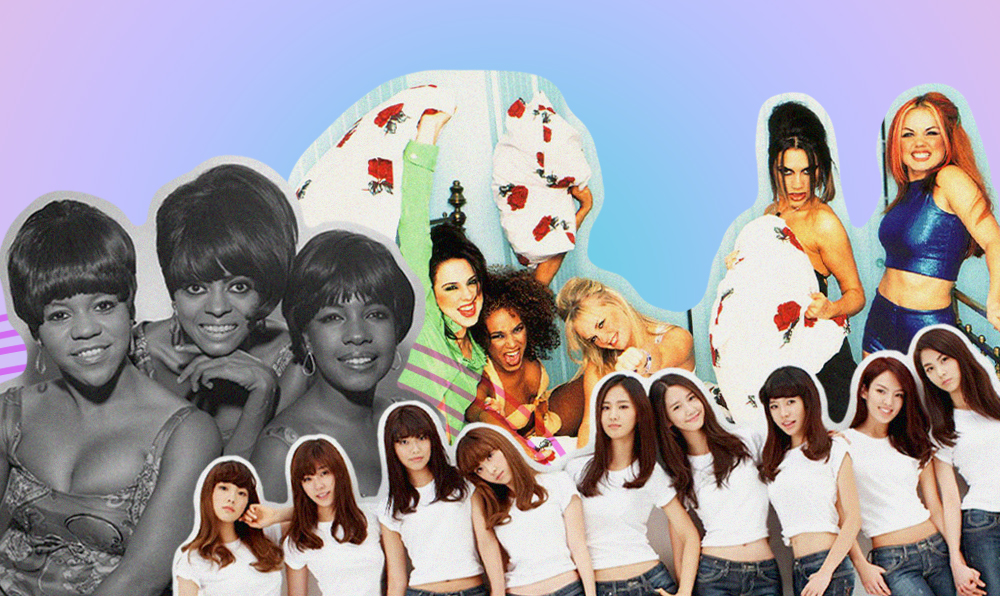Let’s be honest, girl groups are a force to be reckoned with. We all have an idea, at least, of just how hard it is to be an artist in the music industry, let alone a female one. Yet these girls continue to show up every day, complete with hair and make-up, to live singing and intense choreography.
They help make women visible in pop culture, delivering ideas of feminism in the small, bite-sized pieces of “girl power.” Though most of them still operate within a male-dominated industry, it’s important that we continue to celebrate and empower their legacy in exchange for the gift they have given the world—aspiration.
The Rise of Supremes (1940s to 1960s)
Though there were all-female singing groups already like The Boswell Sisters, it was The Andrews Sisters—LaVerne, Maxene, and Patty Andrews—that popularized girl groups during the war period of the 1940s with their song “Boogie Woogie Bugle Boy.”
From then on, the image of three girls singing harmonies in coordinated costumes became a staple in pop culture. The Shirelles were the first one to hit a number one single in Billboard’s Hot 100 with “Will You Still Love Me Tomorrow?” while The Ronettes rocked the world with one of the most critically acclaimed songs of all-time “Be My Baby.”
Across the globe, Indonesia’s garage rock band Dara Puspita braved pressures from a national government that saw rock music as a threat, while Korea’s The Kim Sisters were one of the first music groups from the country to enter the U.S. market.
The Swinging Sixties was also an era of cultural revolution for women and youth. The Supremes’ string of upbeat and optimistic songs, like “You Can’t Hurry Love” where lead singer Diana Ross sings “I need love, love / To ease my mind,” greatly appealed to younger generations who were driven by fun-loving, hedonistic, and modern ideals.
The Space Age (1970s to 1980s)
Taking the mantle from Diana Ross & The Supremes were a wave of girl groups that gave the sound a new flavor. Patti LaBelle and the Bluebelles rebranded as the glam-rock, funk trio Labelle in 1971, ditching their wigs and dresses in favor of Afros and space-age costumes. The group is best embodied by the hit “Lady Marmalade.”
LaBelle is also referred to as a pioneer of disco, which soon enough rose to popularity for its erotic and escapist nature. The genre also became an avenue for dance, fashion, and queer expression.
During this time, girl group hits like The Pointer Sisters’ “I’m So Excited” and Sister Sledge’s “We Are Family” flourished as they sang about grooving and coming together. This phenomenon would continue into the next few years, coinciding with the start of the HIV/AIDS epidemic and the growing movement for gay liberation.
The Underground Movement (mid-1980s to early 1990s)
The fall of disco in the early ‘80s gave rise to girl groups that traded glitzy costumes and sounds for something more unpolished. Some hits of this transition period include The Go-go’s “We Got the Beat,” Bananarama’s “Cruel Summer,” and Wilson Phillips’ “Hold On.”
This was also the time when the “girl power” brand started becoming synonymous with girl groups. En Vogue’s 1992 hit “Free Your Mind” bravely questioned the prejudice Black women face with lyrics such as “I can’t change your mind / You can’t change my color.”
But if there’s one girl group that dominated this era in every way possible, it’s R&B trio TLC. From “Ain’t 2 Proud 2 Beg” to “No Scrubs”, members T-Boz, Left Eye, and Chilli enjoyed a decade-long career, often tackling socio-political issues minorities face in their songs. For instance, 1995’s “Waterfalls” touched on drugs and promiscuity during the peak of the HIV/AIDS epidemic.
The Turn of the Century (late 1990s to mid-2000s)
Taking cues from TLC, girl groups of this period started fully incorporating choreographies and fashion as part of their performance. The “girl power” brand was also in full force, with many groups bringing female empowerment at the forefront of pop culture.
Spice Girls, the best-selling girl group of all time, hit big with their debut single “Wannabe.” Members Scary, Sporty, Baby, Ginger, and Posh often sing about friendship and sisterhood in their songs—themes that still resonate with girl groups today.
Meanwhile, Destiny’s Child’s Beyoncé, Kelly, and Michelle brought new perspectives to female pop music, namely financial independence and body positivity. In “Independent Women, Pt. 1,” Kelly reminds us “The shoes on my feet / I bought it.”
During this time, dance-centric girl groups like The Pussycat Dolls and our very own SexBomb Girls also rose to popularity, with the latter even having their own show “Daisy Siete” which ran for 26 seasons. In Japan, AKB48 debuted in 2005, reviving the country’s idol craze which would soon reverberate throughout Asia.
Overall, this period was crucial in building the foundations for the image and sound of girl groups that we know now, including Little Mix, Fifth Harmony, and the hundreds more to come from K-pop alone.
The New World (late 2000s to present)
Though Blackpink stands as the face of girl groups today with their immense global power, it was Girls’ Generation that opened doors for K-pop girl groups after their sustained success put female idols in the limelight. They stand to this day as “The Nation’s Girl Group,” whose debut single “Into The New World” is even played in South Korean women’s protests.
There’s also 2NE1 whose rugged image resonated with many fans, embracing their insecurities in songs like “Ugly” a la TLC’s “Unpretty.” f(x)’s Amber and Sulli stood firm against feminine stereotypes, opening conversations about gender expression and mental health. Meanwhile, Mamamoo stands as contemporary feminist icons. In “Yes I Am,” vocalist Solar sings “My face is more round than V-line / I like it.”
K-pop’s rise to popularity continues to open new doors for girl groups, who are now able to explore new concepts and sounds that redefine pop music. Korea’s Aespa merges cyberpunk concepts with old-school K-pop, Japan’s Atarashii Gakko flips the typical cute and frilly look of Japanese idol groups by donning long skirts, while Philippines’ Bini reinvents the idol sound for P-pop and OPM.
Behind these big names in flashy lights are stories of real women who are continuously fighting for their own autonomy. It’s no wonder then that the sheer magic of girl groups have continued to inspire many generations of little girls and queer kids to be themselves and own their dreams. And on that note, long may she reign!
Art by Pammy Orlina
Follow Preen on Facebook, Instagram, Twitter, YouTube and Viber


